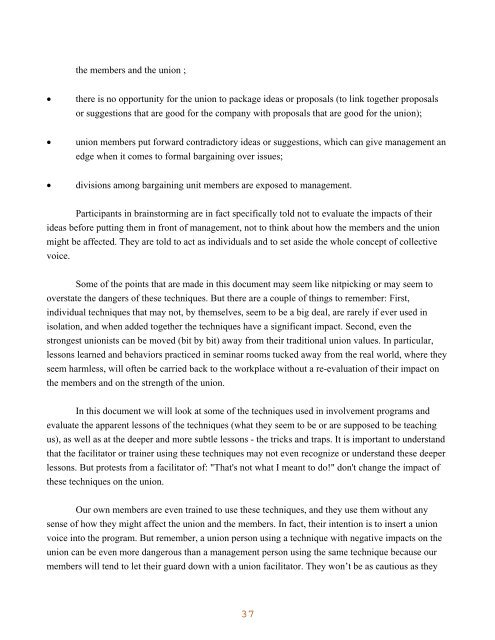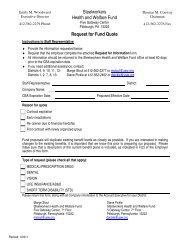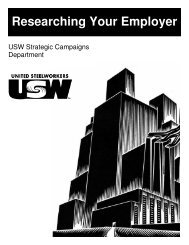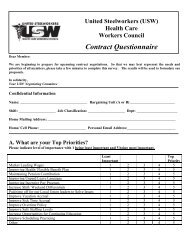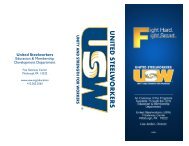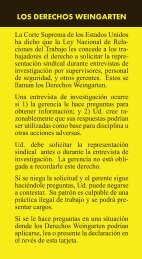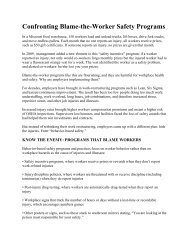Union Approach to Health and Safety: - United Steelworkers
Union Approach to Health and Safety: - United Steelworkers
Union Approach to Health and Safety: - United Steelworkers
You also want an ePaper? Increase the reach of your titles
YUMPU automatically turns print PDFs into web optimized ePapers that Google loves.
the members <strong>and</strong> the union ;<br />
• there is no opportunity for the union <strong>to</strong> package ideas or proposals (<strong>to</strong> link <strong>to</strong>gether proposals<br />
or suggestions that are good for the company with proposals that are good for the union);<br />
• union members put forward contradic<strong>to</strong>ry ideas or suggestions, which can give management an<br />
edge when it comes <strong>to</strong> formal bargaining over issues;<br />
• divisions among bargaining unit members are exposed <strong>to</strong> management.<br />
Participants in brains<strong>to</strong>rming are in fact specifically <strong>to</strong>ld not <strong>to</strong> evaluate the impacts of their<br />
ideas before putting them in front of management, not <strong>to</strong> think about how the members <strong>and</strong> the union<br />
might be affected. They are <strong>to</strong>ld <strong>to</strong> act as individuals <strong>and</strong> <strong>to</strong> set aside the whole concept of collective<br />
voice.<br />
Some of the points that are made in this document may seem like nitpicking or may seem <strong>to</strong><br />
overstate the dangers of these techniques. But there are a couple of things <strong>to</strong> remember: First,<br />
individual techniques that may not, by themselves, seem <strong>to</strong> be a big deal, are rarely if ever used in<br />
isolation, <strong>and</strong> when added <strong>to</strong>gether the techniques have a significant impact. Second, even the<br />
strongest unionists can be moved (bit by bit) away from their traditional union values. In particular,<br />
lessons learned <strong>and</strong> behaviors practiced in seminar rooms tucked away from the real world, where they<br />
seem harmless, will often be carried back <strong>to</strong> the workplace without a re-evaluation of their impact on<br />
the members <strong>and</strong> on the strength of the union.<br />
In this document we will look at some of the techniques used in involvement programs <strong>and</strong><br />
evaluate the apparent lessons of the techniques (what they seem <strong>to</strong> be or are supposed <strong>to</strong> be teaching<br />
us), as well as at the deeper <strong>and</strong> more subtle lessons - the tricks <strong>and</strong> traps. It is important <strong>to</strong> underst<strong>and</strong><br />
that the facilita<strong>to</strong>r or trainer using these techniques may not even recognize or underst<strong>and</strong> these deeper<br />
lessons. But protests from a facilita<strong>to</strong>r of: "That's not what I meant <strong>to</strong> do!" don't change the impact of<br />
these techniques on the union.<br />
Our own members are even trained <strong>to</strong> use these techniques, <strong>and</strong> they use them without any<br />
sense of how they might affect the union <strong>and</strong> the members. In fact, their intention is <strong>to</strong> insert a union<br />
voice in<strong>to</strong> the program. But remember, a union person using a technique with negative impacts on the<br />
union can be even more dangerous than a management person using the same technique because our<br />
members will tend <strong>to</strong> let their guard down with a union facilita<strong>to</strong>r. They won’t be as cautious as they


